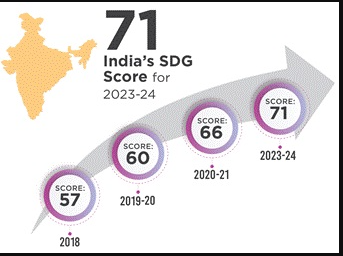Note4Students
From UPSC perspective, the following things are important :
Prelims level: SDG India Index
Mains level: Key highlights and results from the fourth edition of the SDG India Index
Why in the news?
Overall SDG score for the country is 71 for 2023-24, significant improvement from 66 in 2020-21 and 57 in 2018 (Baseline report).

About SDG India Index:
- The SDG India Index is a comprehensive tool developed by NITI Aayog to measure the progress of India and its states/UTs towards achieving the Sustainable Development Goals (SDGs).
- The index tracks the progress on 113 indicators aligned with the National Indicator Framework of the Ministry of Statistics and Programme Implementation (MoSPI).
Key highlights and results from the fourth edition of the SDG India Index:
- Top Performers: Uttarakhand and Kerala secured the top spots with a score of 79 out of 100, showcasing strong performance across Sustainable Development Goals (SDGs) such as poverty eradication, health, education, and environmental sustainability.
- National Improvement: India’s overall SDG score improved from 66 points in 2020-21 to 71 points in 2023-24, indicating significant progress in achieving the SDGs nationwide. This improvement reflects efforts in poverty reduction, economic growth, and environmental conservation.
- State-wise Variations: Bihar ranked lowest with 57 points, indicating areas needing more attention and development. States like Punjab, Manipur, West Bengal, and Assam showed notable improvements, with Punjab leading the pack with an increase of 8 points to reach 76 points.
- Goal-specific Insights: Goals such as “No Poverty,” “Decent Work and Economic Growth,” and “Life on Land” saw the highest increases in scores, reflecting advancements in income equality, employment opportunities, and biodiversity conservation efforts.
- Challenges and Focus Areas: Gender Equality received the lowest score at 49 points, highlighting persistent challenges in achieving parity in workforce participation, education access, and political representation. Addressing issues related to hunger and nutrition remains a priority, with the “Zero Hunger” goal scoring 52 points, emphasizing the need for nutritious food access and combating malnutrition.
How did States and UT performed?
- Score Ranges: States’ scores range from 57 to 79, while UTs score between 65 and 77. This indicates an improvement compared to the 2020-21 scores, where the range was 52 to 75 for States and 62 to 79 for UTs.
- Front Runner Category: There has been a significant increase in the number of States and UTs achieving Front Runner status. In the latest edition, 32 States/UTs scored between 65 and 99, up from 22 in the previous edition. Notably, 10 new States and UTs entered the Front Runner category, including Arunachal Pradesh, Assam, Chhattisgarh, Madhya Pradesh, Manipur, Odisha, Rajasthan, Uttar Pradesh, West Bengal, and Dadra and Nagar Haveli and Daman and Diu.
- Score Improvements: Across all States and UTs, there has been improvement in composite scores ranging from 1 to 8 points since the 2020-21 edition. Leading in score improvements are Assam, Manipur, Punjab, West Bengal, and Jammu and Kashmir, each showing an increase of 8 points.
- Methodology: The methodology involves compiling raw data for indicators, setting 2030 targets, normalizing data to a 0-100 score, and calculating Goal scores as means of relevant indicators. The composite score represents an average of all Goal scores, excluding Goal 14 focused solely on coastal States.
Way forward:
- Targeted Interventions for Lagging States: Implement customized, data-driven interventions in States with lower scores, such as Bihar, to address specific challenges in poverty, health, and education.
- Enhance Focus on Gender Equality and Nutrition: Strengthen policies and programs aimed at improving gender equality and combating malnutrition, particularly by increasing female workforce participation and ensuring access to nutritious food.
Get an IAS/IPS ranker as your 1: 1 personal mentor for UPSC 2024

